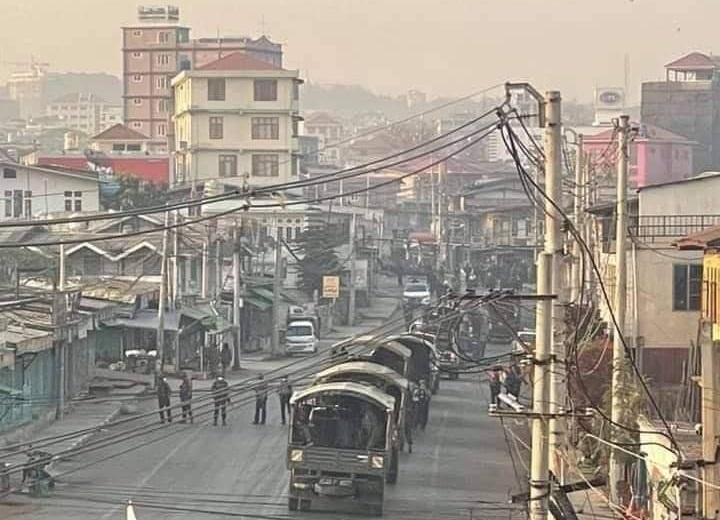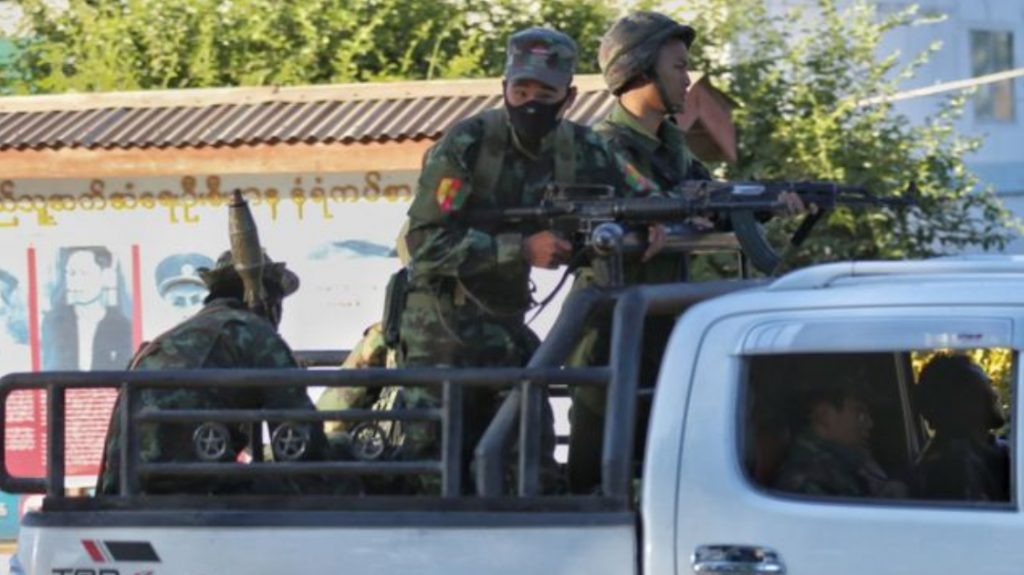Recently, Myanmar Now posted an analysis piece on junta people’s war strategy which is worth analyzing as it dwells on the question of whether the Military, Tatmadaw or Myanmar army is now on the verge of disintegration.

According to the report titled, “Defeat of the coup generals’ people’s war grand strategy” begins with the opening phrase “The military council (junta) was hit by well-armed and experienced Chin and Kayah (Karenni) states resistance groups, where even the bodies of its troopers could not be retrieved in some places, according to some photos posted on social media after the fighting.”
Lack of local people’s cooperation is the main cause of Tatmadaw’s defeat said Captain Lin Htet Aung, who has defected to the civil disobedience movement (CDM).
“Lack of public support, lack of astute knowledge of the regions, war weariness with declining moral, the junta’s troops were unable to imagine from where and how the attacks will unfold, led them to living a miserable life. These are the main factors that make them lose. What I mean is that the junta people’s war strategy has completely collapsed, ”said Captain Lin Htet Aung, who served as commander of the 528th Light Infantry Battalion in eastern Shan State until early April.
According to the “People’s War Strategy” set by the military junta, the key role of local people is in keeping the news of an area up-to-date and to mobilize the people to win a variety of operations.
The reason for the lack of public cooperation was rightly pin-pointed by an ex-communist turned political analyst.
“They realize how much hatred and bitterness there are among the people because of the crimes they have committed,” he said. “I think they are keeping their individual movements more secretive when they sense a little bit of public hatred and resentment, ”said Than Soe Naing, who has been an armed rebel of the Burmese Communist Party for 15 years on the Sino-Burmese border.
Similarly, the Rangoon-based Urban Guerrilla Revolution Force (UGRF) in charge of monitoring the military junta situation said, “So they already know it’s dangerous to go alone and they have to move from one place to another only in groups.”
The UGRF is one of Rangoon-based rebel groups that often bombed businesses in Rangoon linked to the military council.
Because the People’s Defense Forces (PDF) loyal or sympathetic to the parallel National Unity Government (NUG) have been bombing the Ward Administration Office Township, Electricity Meter Office, and the traffic police station on a daily basis, it is creating difficulties for the junta’s administrative machinery.
NUG’s Defense Minister U Ye Mon said that the NUG declared war on September 7 and chose the strategy to involve all the people in the ongoing struggle to overthrow the military dictatorship.
“It is a resistance war with the participation of the people. The guerrilla movement will be the main backbone of the militia strategy in various forms of combat. However, there is also a possibility of major battle could emerge in some areas, ” said the defense minister, according to the Myanmar Now recent report.
Some PDF loyal to NUG and some on their own have been multiplying since the brutal crackdown of the people’s protest against the coup-maker junta.
“They (the resistance) are getting bigger because the people are very angry and cannot forgive,” said Dr. Mimi Winbert, who has trained Myanmar officers to improve civilian-military relationship.
“Another thing is that concerning corona-virus it was believed the people were not provided protection. There, too, they became even angrier. And their future, dreams and aspirations have all vanished,” she added, according to Myanmar Now.
Militias in Myanmar
According to John Buchanan in his report titled, “Militias in Myanmar”, published by The Asia Foundation, in July 2016, he discussed four types of militias. They are: Tatmadaw-integrated militias; Tatmadaw non-integrated militias; Tatmadaw-supported community militias; and Ethnic armed organization militias.

The junta is concerned by the first three types, whereas the last one is run by the Ethnic Armed Organizations (EAOs) which are either actively or inactively pitted against the Myanmar military junta.
In 2009 and 2010, Tatmadaw leaders pressured EAOs that had agreed to a ceasefire – so-called
ceasefire groups – to join its Border Guard Force (BGF) and People’s Militia Force (PMF) programs, in an attempt to bring Myanmar’s armed groups under its command as called for in the 2008 Constitution. But were never realized fully as the stronger EAOs resisted the call and in effect have been on the war-footing regardless of the Nationwide Ceasefire Agreement signed with ten EAOs in October 2015 during President Thein Sein’s tenure. Another stronger EAO alliance Federal Political Negotiation Consultative Committee (FPNCC) is not part of it and also the Karenni National Progressive Party (KNPP).
According to Buchanan the militias may number about 80,000. A coalition of ethnic armed groups and some members of the Tatmadaw became the BGF. There are 26 BGF in Kachin, Karen, Kayah (Karenni) and Shan states, including 52 PMF.
According to Than Soe Naing, the majority militias have only name.
“They may give information, carry things for the Tatmadaw and mean to increase the strength of the militias. They have only quantity but never the quality,” he said.
However, to what extend the junta can rely on its BGF and PMF is an open question with the rising tide of revolutionary spirit among the heartland Bamar regions’ population and the resistance movement gaining momentum.
Junta’s recruitment problematic and defection
Recruitment of younger generation to enter Military Academies, Military Technological University and the Medical University has also become problematic as they are almost all against the military that belong to so-called Generation Z, and actively been involved in the resistance and revolutionary movement to uproot the military dictatorship.
Recruitment applications have been extended several times to woo the enrollment in military learning institutions since June 16. But unlike the pre-coup situation only few have applied and those who did were mostly from within the military family circles.
Apart from recruitment quandaries the junta’s trouble is compounded by mass defection of its troops, due to the public hatred of the military because of the junta’s thuggish, barbaric cruelties, which could be termed as crime against humanity and war crimes; the corresponding degradation of social status in the eyes of the public as an outcast institution; and most importantly, the public commitment to do away with the military dictatorship institution, which selfishly serves only the military class and its top brass, once and for all.
To date, more than 2,000 to 3,000 soldiers and policemen have defected to the opposition or joined the CDM, which is gaining momentum. Reportedly, connections that were installed to guide the would-be defectors are said to be overwhelmed, with no less than 400 inquiries daily, according to the media.
“In a recent interview, NUG health minister Dr Zaw Wai Soe said, without elaborating, that 3pc of the Tatmadaw’s forces have already deserted or defected, and that if 0.4pc more leave, it would “necessarily lead to the institutional collapse of the military as a domino effect”. However, this would mean that about 10,000 soldiers have defected already, and regardless of the accuracy of that number, there is no theory that says the defection of 3.4pc of its personnel would trigger its institutional collapse,” according to Frontier Myanmar in it recent report of September 16.
“Some Tatmadaw officers who have defected to the Civil Disobedience Movement say that most soldiers have been demoralized by the brutal suppression of the public they vowed to protect,” the report writes.
Adding, “On top of this, soldiers may see the coup itself as having been staged unnecessarily for the personal interests of the top generals rather than the benefit of the rank and file.”
The military council was previously estimated to have more than 400,000 troops, but some estimate that the battalions may be fielding as low as 200,000 due to under-strength deployment as observed by military watcher, according to Frontier Myanmar. Thus, the number of real combat troops count is also questionable.
Present Situation
The armed conflict has heightened in Myanmar’s heartland like Sagaing, Mandalay, Magwe, Yangon, Bago and to a lesser extent other regions also, in form of bombing soft targets like civil administration offices, junta’s business premises, electricity bill payment offices, traffic police stations; and assassination of junta’s informers generally in Bamar populated regions.
Likewise, the ethnic states have also been ravaged with firefights between the EAOs and PDF combined in many instances like in Chin and Karenni states, while Karen State is also seeing increased armed conflict, due to the offensives of the Tatmadaw, especially in Brigade 5 Mutraw area. The Kachin State is also a fierce conflict zone, with the Tatmadaw reinforcing its troops to battle the KIA. Northern Shan State, particularly in Kokang area has also seen increased armed engagement recently, while Kutkai area has a constant on-and-off firefights all through out the month. The Mon and Arakan states are almost armed conflict free, especially the latter since last year November, due to the unofficial ceasefire agreement made between itself and the Tatmadaw. However, whether this arrangement will go on further or fall back into armed conflict again is anybody’s guess, the Tatmadaw is only tolerating the Arakan Army (AA) because it doesn’t like to open another war front in Arakan State and spread itself thinner that it is now enduring.
Analysis
Given the above mentioned facts and reasoning, the junta may be failing to keep up with its people’s war doctrine or strategy. But the NUG may be winning ground by making use of the strategy where the Tatmadaw has failed.
First, the Tatmadaw isn’t as strong as 400,000 as believed but maybe less than 200,000 taking cue from its under-strength battalion deployment. Secondly, the hatred of the people on the junta because of its brutality, the people’s war strategy which are based on people’s militias formed by the junta, purposely as informant network are not working, because it cannot protect them from people’s retaliation and attacks, which is confirmed by the military spokesman himself. Finally, the people’s war strategy is working for the resistance and revolution as the people are determined to get rid of the military dictatorship, once and for all.
Thus, if the observation of the situation is credible for at least fifty percent, the implosion of the Tatmadaw may become a reality, as no regime can hold on for long if the whole population is against its rule, unless of course if it can cow the people to total submission like North Korea’s dictator.
However, in closing if the ethnic-democratic camps would feverishly find a way to coordinate and cooperate in the form of political and military alliance or all-embracing coalition, the implosion of the coup-maker, military junta will hasten and the push to achieve people’s aspirations will accelerate. But if this could not be pulled through for whatever reason, the country might either be bogged down in slow burning civil war for a long time or become an ungovernable fragmented failed state eventually, whether we like it or not.



